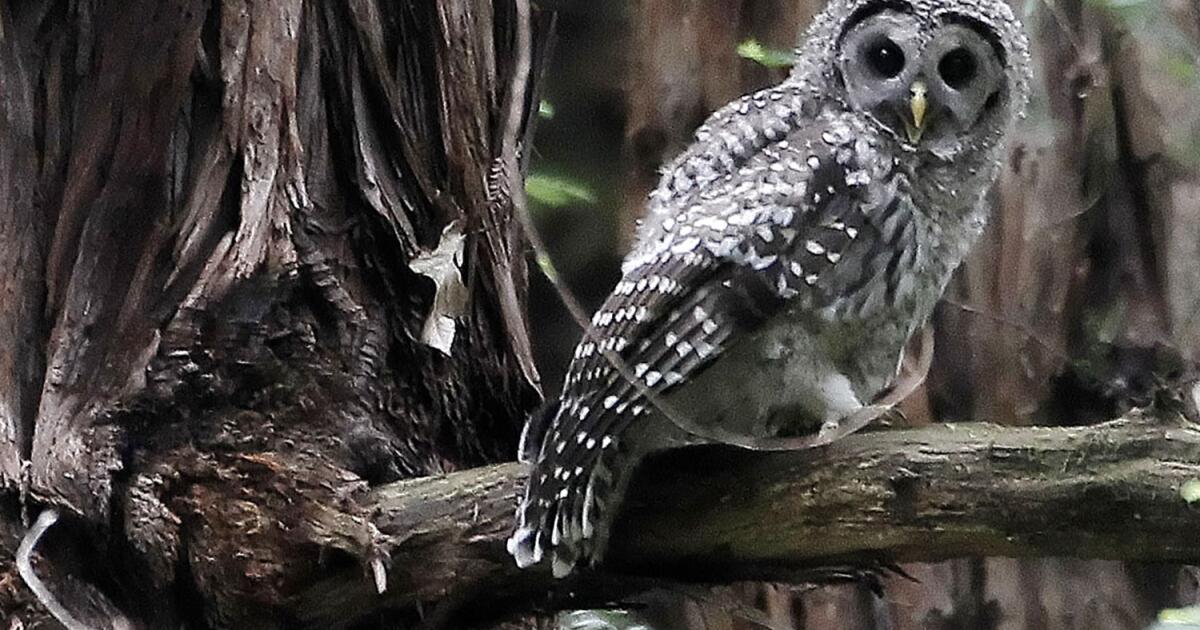Plan to kill 450,000 owls creates odd political bedfellows — loggers and environmentalists
The strange political bedfellows created by efforts to save spotted owls in the Pacific Northwest just got even stranger.
Already Republican members of Congress were allied with animal rights activists.
They don’t want trained shooters to kill up to 450,000 barred owls, which are outcompeting northern spotted owls, under a U.S. Fish and Wildlife Service plan approved last year that would unfold over three decades.
Now, timber interests are aligning with environmentalists in favor of culling the owls.
Some logging advocates are afraid nixing the plan will slow down timber harvesting. Roughly 2.6 million acres of timberlands in western Oregon managed by the Bureau of Land Management are governed by resource management plans contingent on the barred owl cull going forward, according to Travis Joseph, president and chief executive of the American Forest Resource Council, a trade association representing mills, loggers, lumber buyers and other stakeholders in the region.
The area can produce at least 278 million board feet per year under current plans, “with the potential for significantly more,” Joseph said in a mid-October letter to Congress.
If the cull is scrapped, he said, the federal agency likely will need to restart Endangered Species Act consultation for the northern spotted owl, which is listed as threatened. It’s a process that could take years. According to the letter, it would create “unacceptable risks and delays to current and future timber sales.”
Timber production goals laid out by the Trump administration also could be jeopardized.
Momentum to stop the cull gained ground this summer when Sen. John Kennedy, a conservative from Louisiana, introduced a resolution to reverse the Biden-era plan.
That move reflected an unlikely alliance between some right-wing politicians and animal rights advocates who say it’s too expensive and inhumane. Some Democrats have also opposed the cull, and companion legislation in the House has bipartisan backers.
The stakes are high. Many environmentalists and scientists maintain that northern spotted owls will go extinct if their competitors aren’t kept in check. Barred owls — which originally hail from eastern North America — are larger, more aggressive and less picky when it comes to habitat and food, giving them an edge when vying for resources.
Last week, Politico’s E&E News reported that Kennedy said Interior Secretary Doug Burgum asked him to stand down from his effort to stop the owl-killing plan. The legislator told the outlet he would charge ahead anyway.
“I don’t think the federal government ought to be telling God, nature — whatever you believe in — this one can exist, this one can’t,” Kennedy told E&E. “The barred owl is not the first species that has ever moved its territory and it won’t be the last.”
Kennedy did not respond to The Times’ request for comment. A spokesperson for the Department of the Interior said they could not respond to the inquiry because of the government shutdown.
“It’s strange that a Republican in the south is taking on the owl issue, specifically, when its consequences will impact western Oregon BLM timber sales,” Joseph said in an interview. “It will lead to lower revenues for counties, it will impact jobs and it will put the spotted owl on a trajectory towards extinction.”
The stance aligns in part with that of environmental groups like the Environmental Protection Information Center and Center for Biological Diversity, which have supported culling barred owls to help the beleaguered spotted owls in their native territory. It’s an unexpected overlap, given environmentalists’ long history of fighting to protect old-growth forests in the region the owls call home.
Tom Wheeler, chief executive of EPIC, said it’s possible that culling barred owls could lead to a bump in timber harvest on the BLM land in western Oregon but overall it would lead to more habitat being protected throughout the spotted owls’ expansive range. The presence of spotted owls triggers protections under the Endangered Species Act. If the cull boosts the spotted owl population as intended, it means more guardrails.
“It puts us in admittedly an awkward place,” Wheeler said. “But our advocacy for barred owl removal is predicated not on treating the northern spotted owl as a tool against the timber industry and against timber harvest. What we’re trying to do is provide for the continued existence of the species.”
Many Native American tribes support controlling barred owls in the region. In a letter to Congress last week, the nonprofit Intertribal Timber Council said barred owls threaten more than the spotted owl.
“As a generalist predator, it poses risks to a wide range of forest and aquatic species that hold varying degrees of social and ecological importance to tribes, including species integral to traditional food systems and watershed health,” wrote the council, which aims to improve the management of natural resources important to Native American communities.
Since 2013, the Hoopa Valley tribe in Northern California has been involved with sanctioned hunting of the owls and has observed the spotted owl population stabilizing over time, according to the letter.
However, groups like Animal Wellness Action and Center for a Human Economy argue that the plan to take out so many barred owls over a vast landscape won’t work, aside from the high owl death toll. More barred owls simply will fly into where others were removed, said Wayne Pacelle, president of both groups.
That makes habitat key — and the prospect of losing more to logging in western Oregon devastating, according to Pacelle.
To stop the owl-culling plan, both chambers of Congress would need to pass a joint resolution and President Trump would need to sign it. If successful, the resolution would preclude the agency from pursuing a similar rule, unless explicitly authorized by Congress.
The plan already faced setbacks. In May, federal officials canceled three related grants totaling more than $1.1 million, including one study that would have removed barred owls from over 192,000 acres in Mendocino and Sonoma counties

